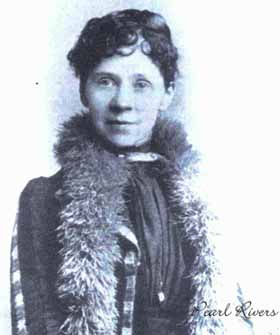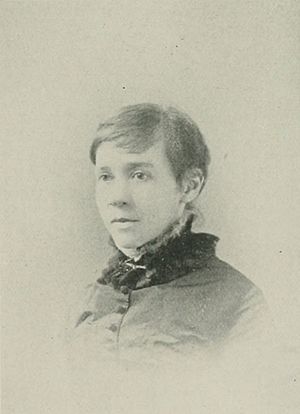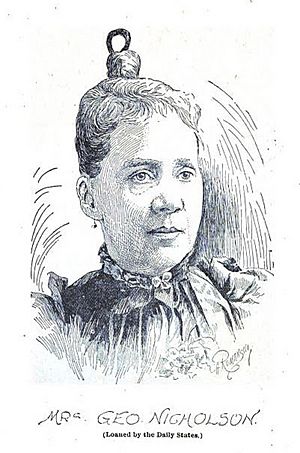Pearl Rivers facts for kids
Quick facts for kids
Pearl Rivers
|
|
|---|---|

Eliza J. Nicholson
|
|
| Born | Eliza Jane Poitevent March 11, 1843 Gainesville, Mississippi |
| Died | February 15, 1896 (aged 52) New Orleans, Louisiana |
| Resting place | Metairie Cemetery |
| Pen name | Pearl Rivers |
| Occupation | Journalist, poet |
| Language | English |
| Nationality | American |
| Alma mater | Amite Female Seminary, Liberty, Mississippi |
| Period | 1859-1896 |
Pearl Rivers (whose real name was Eliza Jane Nicholson, born Poitevent) was an American journalist and poet. She made history as the first female editor of a major American newspaper. She started as the literary editor of the New Orleans Times Picayune. In 1876, she became the owner and publisher after her husband passed away. By 1880, she was also the managing editor, a role she held until her death in 1896.
She chose the name "Pearl Rivers" from the Pearl River. This river was close to her home in Mississippi. Pearl Rivers didn't let old-fashioned rules stop her. She pursued her newspaper career even when her family and society didn't approve.
Contents
Early Life and School Days
Eliza Jane Poitevent was born in Gainesville, Mississippi, on March 11, 1843. She was the third of five children in a busy family. When she was nine, she moved to her aunt Jane's house. This was near what is now Picayune, Mississippi. Her uncle managed a farm, a store, and a toll bridge.
She went to the Amite Female Seminary in Liberty, Mississippi. She graduated in 1859. She was known as the "wildest girl in school." During the American Civil War (1861–1865), she wrote poems about a soldier she may have loved. These poems were published in 1866 in the New Orleans Times.
Starting Her Career
After the war, Eliza began sending her writings to newspapers and magazines. She used the pen name "Pearl Rivers." Her poems appeared in The South in New Orleans. They were also in the New York Home Journal and the New York Ledger. On October 17, 1866, The Picayune in New Orleans published her poem "A Little Bunch of Roses." After 1867, all her work was published in this paper.
During a visit to New Orleans, she met Alva M. Holbrook. He was a co-owner of The Daily Picayune. He asked her to become the newspaper's literary editor. She accepted the job. In May 1872, she married Holbrook. He was much older than her. Their marriage was difficult. Holbrook passed away in 1876. He left the newspaper to his young wife. This was a brave choice for a woman at that time. She then married George Nicholson in June 1878. He was the paper's business manager.
Leading the Picayune
George Nicholson was a skilled businessman. He helped pay off the newspaper's debts. He also increased its advertising income. Pearl Rivers brought many new ideas to The Daily Picayune. These changes greatly increased how many people read the paper. It became one of the most important newspapers in the South.
She added many new sections. These included stories for women, sports news, and pages for children. She also added poetry and literary stories. She even started a gossip column. Pearl Rivers hired Dorothy Dix, who became famous for her advice column. In 1881, she hired Martha R. Field. Martha was the paper's first paid woman reporter. She wrote popular columns like "Catherine Cole's Letter."
On March 16, 1879, she started a society column called "Society Bee." Some readers thought it was wrong to mention ladies' names in a newspaper. But by 1890, this column was the biggest part of the Sunday paper. Many other newspapers copied it.
The newspaper's look also changed. Ads moved into special boxes. Before 1885, the paper rarely had pictures. By 1887, the pages were full of drawings. A fun character called the Weather Frog appeared in cartoons starting in 1894. Pearl Rivers turned the paper into a family newspaper. Between 1880 and 1890, the number of readers more than tripled. The paper also grew in size and influence.
Under Pearl Rivers, the paper fought against corruption. It shared strong opinions on public projects for the Mississippi River. It supported building railroads and pushed for political changes. The paper grew to be very influential.
Groups and Causes
Pearl Rivers became the first president of the National Woman's Press Association in 1884. She was also the first honorary member of the New York Women's Press Club. In 1886, she was invited to be vice-president of the Audubon Society. The editor thought she was a man at first! He later apologized for his mistake.
Pearl Rivers loved animals. She wrote articles criticizing dog fighting. She also spoke out against beating horses and mules. She was a key person in starting the New Orleans Society for the Prevention of Cruelty to Animals in 1888.
Personal Life and Passing
Her husband, George Nicholson, caught the flu and passed away in New Orleans. Pearl Rivers died from the same illness two weeks later, on February 15, 1896. She left behind two teenage children.
Her Writings
Pearl Rivers' early poems often focused on nature. Some also touched on love and sadness. A critic named Dr. W.H. Holcomb praised her book Lyrics. He said she was ahead of other Southern poets. He also said few other American women writers showed more poetic talent.
Here is an example of her early poetry:
-
- Whistling through the corn field,
Whistling a merry air,
My feet are deep in the pea-vines,
And tangles are in my hair.
- Whistling through the corn field,
-
- Old folks say 'tis unlucky
For maidens to whistle; still,
Life is a rugged country,
And whistling helps uphill.
- Old folks say 'tis unlucky
In her poem Myself, she wrote about her early life. She mentioned the "gossip-loving bee." This bee later gave its name to her "Society Bee" newspaper column.
Her later works, "Hagar" and "Leah," were published in Cosmopolitan in 1893 and 1894. These poems showed more depth. They shared strong feelings of bitterness and jealousy from her characters.
However, her most important work was in journalism. She wrote in a lively and fun way. She gave smart and thoughtful comments on many important issues of her time. Even though she sometimes doubted herself, Pearl Rivers was a truly amazing and insightful writer.
Selected Works
- Pearl Rivers (1873). Lyrics. BiblioBazaar, LLC (2008 reprint). ISBN 0-554-56958-2.



